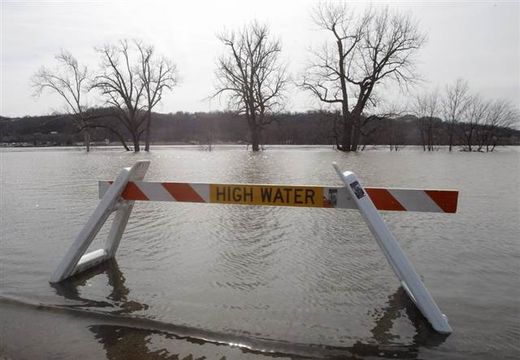
The complex storm system means severe storms in parts of eastern Oklahoma, and heavy rainfall from the Lower Mississippi Valley on east, The Weather Channel reported, with the possibility of some snow following on its heels over the weekend and into next week.
Central and northern New York would likely see a mix of rain and snow because of the system, The Weather Channel said, before rain would hit northern New England.
A series of systems bearing rain and snow was expected to start moving across the Pacific Northwest and Northern California, the forecasters said.
'Widespread rains'
The National Weather Service issued flash flood watches for parts several states.
For portions of Illinois and Missouri, the flash flood watch was to continue into late Friday night, with the weather service warning that the combination of heavy rain and ground saturated from recent wet weather make flash floods possible.
"Widespread rains from one to two inches are expected ... These rains will cause water levels to rapidly rise on the smaller creeks and streams" in the affected areas, the notice said.
Across the Mid South region, forecasters said that conditions would "result in widespread showers and thunderstorms that will produce heavy rainfall. The heaviest rains will fall in areas where thunderstorms move repeatedly over the same areas," the bulletin said.
Parts of northern Mississippi and western Tennessee would feel the brunt of the action, the forecasters said.
Flash flooding could also be expected in southwestern Indiana and western Kentucky, the service said.
"With soil conditions still quite moist from recent rain events, it will not take long for any heavy rains to result in a runoff situation. Creeks and streams could rise quickly and roadways may become flooded," the bulletin warned, adding that the situation would also aggravate ongoing river floods, especially in the Ohio River Valley.
Flood insurance bill
The warnings came after the Republican chairman of a congressional insurance oversight panel, Rep. Judy Biggert, said Thursday that draft legislation to overhaul the U.S. National Flood Insurance Program would be unveiled next week.
She said told Reuters she would present the draft on March 11 at a hearing of the House insurance subcommittee she chairs, kicking off what could be a lengthy debate on a deeply troubled government program.
"We want to make sure we can find some way that taxpayers aren't going to be on the line for a lot of money, which of course has been the case," Biggert said. "We've got a draft. We're working on it. We'll be bringing it up."
The draft excludes wind damage coverage - a point of contention that wrecked the last overhaul effort in 2009.
"I don't think that we have it in there ... Not so far. I'm sure that somebody will bring it up," she said.
Big insurers with a stake in the NFIP debate include Allstate, Travelers, Hartford Financial Services and Fidelity National Financial.
The NFIP insures more than 5.5 million homes and businesses against floods, the most common of U.S. natural disasters. It has been deeply in debt since the costly hurricanes of 2004 and 2005. Repeated efforts in Congress to fix it have failed.
Standard homeowners' insurance does not cover flooding.
This coverage must be purchased through the NFIP, which is administered by the Federal Emergency Management Agency.
The program provides flood coverage through more than 90 companies that sell policies and collect premiums on the government's behalf for a fee. The premiums go to FEMA.
Since 2008, the program has functioned under a series of short-term extensions. Last year, Congress let the program lapse four times, meaning new flood insurance policies could not be written and complicating thousands of real estate transactions daily in flood-prone regions.
Biggert said her draft does not yet have a firm strategy for dealing with the NFIP's debt.
"We haven't reached that conclusion," she added.
Reuters contributed to this report.



Reader Comments
to our Newsletter